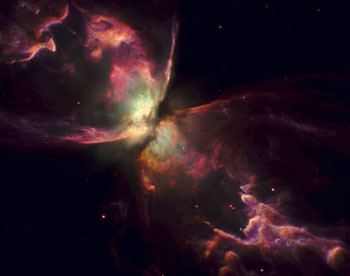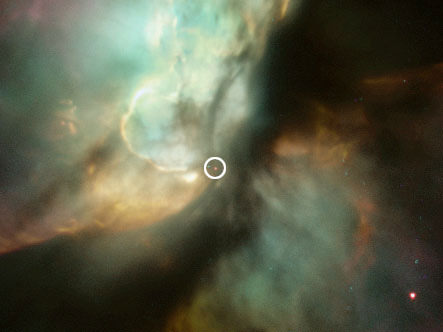No, this article is not about Johnny Depp or Angelina Jolie. They may be hot stars, but in comparison to the star at the center of the Bug Nebula, pictured left, they’ve got nothin’. The first image of the star at the center of the Bug Nebula (NGC 6302) has been taken by a team of astronomers at the Jodrell Bank Centre for Astrophysics, using the newly refurbished Hubble Space Telescope. This star, one of the hottest in the galaxy, has a temperature of about 200,000 Kelvin – 33 times hotter than the Sun – and is at the center of one of the most beautiful planetary nebula in the galaxy.
The star at the heart of the Bug Nebula, which lies about 3500 light-years away from Earth in the constellation Scorpius, is what gives the two lobes of the formation their glow. Its extreme temperature of at least 200,000 K (and possibly up to 400,000 K) ionizes the gas in the nebula, which is itself composed of ejecta from the star as it shed its corona during the later stages of its life. The star has gone through its red giant phase and is now a late-stage white dwarf.
As a comparison to how hot the star powering the luminosity of the Bug Nebula is, our Sun’s hottest temperature is 5,800 Kelvin which is about 5,500 degrees Celsius and almost 10,000 degrees Fahrenheit. The mass of the star is calculated to be 0.64 solar masses, though it was many times heavier than the Sun before it ejected much of its matter into the nebula.
The astronomers were lucky to have been able to image the star at this point in its life, as the light it is emitting is fading at about 1% a year. Professor Albert Zijlstra of the University of Manchester said in an email interview, “The star seems to be in a phase where nuclear burning has ceased very recently (within the past 100-1000 yr). It is radiating its left-over surface heat away, and that goes quickly. At some time heat from interior will take over, and as that is a much larger heat reservoir, the star will fade much more slowly from that point.”
This does not mean, however, that the ionized gas in the nebula will fade out quite as quickly, Zijlstra said. ‘The nebula is ionized by ultra-violet photons from the star. The ionized elements recombine with electrons, before being re-ionized. Normally, there is a good balance between ionizations and recombinations. In NGC 6302, if the star is fading rapidly, it is possible that the time scale for recombinations is longer than the time over which the star fades. The nebula would ‘remember’ a more luminous star, and be ionized to a higher degree than the star could currently support. It is like living off your savings.”
There have been many attempts at imaging this star, but the brightness of the nebula combined with the dust obscuring the star made imaging difficult. Only with the new Wide-Field Camera 3, installed on the Hubble earlier this year, were the astronomers able to make out the star buried in the heart of the Bug Nebula.
Zijlstra said of the Hubble’s capabilities, “It is a combination of sensitivity and available filters. The nebula is very bright, and it is difficult to detect the faint star against the very bright nebular background. To get the best sensitivity, you need high resolution (which dilutes the nebulae light while concentrating the stellar light – this requires HST), good sensitivity and ideally, a filter which excludes the brightest emission lines (H alpha, [O III]). We detected the star with two different filters which select fainter emission lines, which reduces the glare from the nebula. The extinction through the dust in the nebula is also very high, which makes the star even fainter especially in the blue.”
Further observations of the star are definitely in order, including molecular and dust spectroscopy, but Zijlstra said his team does not have any observations of the star planned as of now. The results of the imaging and calculations detailing the properties of the star will be published in The Astrophysical Journal, but a pre-print article is available on Arxiv.
A zoom animation of some of the images put together is also available on the Jodrell Bank Centre for Astrophysics site right here.
Source: Jodrell Bank press release, email interview with Albert Zijlstra


Interesting to read that this planetary nebula is “only” 2200 years old, a blink of an eye in the life of a star. We are indeed lucky to observe a star evolving this rapidly.
The full extent of the obscuring torus (and the planetary itself) can best be seen in the earlier Hubble release here: http://hubblesite.org/newscenter/archive/releases/2009/25/image/f/ . The paper mentions that star completed the ejection of the torus material ~2900 years ago. I wonder if any planets present survived the end of the AGB phase and are now being blasted by the intense radiation of the central star?
At least any life form did not survive! 😉 Even cockroaches shouldn’t last long in such a fierce environment.
Compare this image to the one Universe Today published on Nov. 17th of this year.